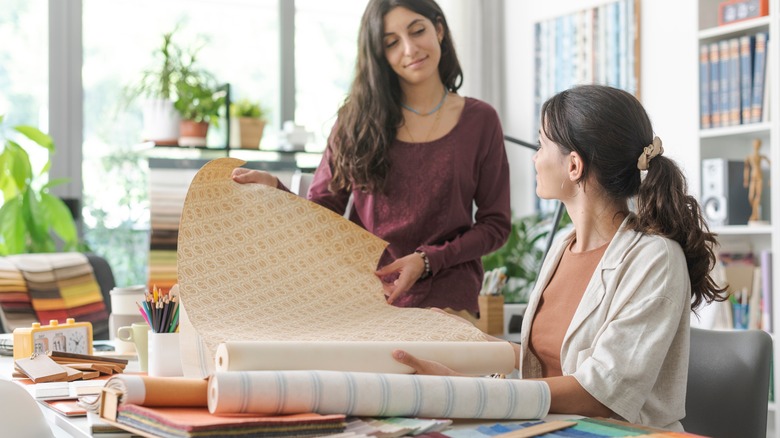The Genius Trick That Makes Picking The Perfect Wallpaper Easier Than Ever
Choosing the perfect wallpaper can be pretty daunting, especially if you're trying to match it to existing elements in the room. For example, if you have tiles installed in your bathroom, how do you choose a piece that would coordinate rather than clash with them? The same goes if you have furniture and knick-knacks in your living room or bold countertops in your kitchen — how do you narrow down your choices so your wallpaper helps tie in that design rather than fights against it? Well, there is an easy way to make it all feel cohesive, and it includes using paint chip samples.
According to interior designer Annie Blair, if your room has some already distinctive colors in it, match those shades to paint chips, and then use those chips to find wallpaper with the same medley of hues. This will help tie the look together, since all the same colors will repeat in its print. In an Instagram post, the designer shared that her daughter's new bathroom featured some interesting vintage tile that had repeating squares of yellow, red, and blue. They wanted to find paper that had the same or similar shades, so they went to the hardware store, picked up a spectrum of shades in that color, and narrowed it down to the closest contenders. They then took those samples to the wallpaper store, and used them to find an option that had the same shades. Here is a closer look at the clever wallpaper hack.
How to use paint chips to figure out your color scheme
This design hack works so well because it helps you figure out the color scheme of your room. Oftentimes, when we decorate, we don't actively think about the color palette of the given space. Instead, we choose items we like and that seem to gel well with the rest of the existing items. But if you took a handful of paint chips and began to match them to different parts of the room, a cohesive color scheme begins to come out.
So how do you do this if you don't have obvious pops of color, like multi-hued tiles? You want to use a similar method but pull colors from both the largest and most eye-popping pieces. For instance, say you're trying to use this wallpaper hack in your living room. Look at the largest things in the room first, like the couch and rug. Find the defining colors in those features, especially if they have more than one color in them. Next, move on to things like artwork or curtains. And lastly, look at the smaller details, like throw pillows and knick-knacks. If you're not a colorful person, you can instead match your paint chips to just three items. This follows the 60-30-10 interior design room, which states you should have three predominant hues in a room. The dominant one should take up 60% of the space, the secondary one should complement it and take up 30%, while the bolder accent color should just occupy 10%.
